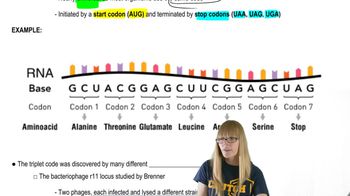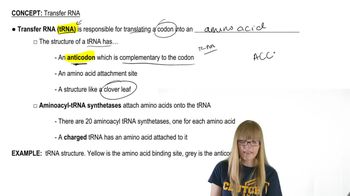Table of contents
- 1. Introduction to Genetics51m
- 2. Mendel's Laws of Inheritance3h 37m
- 3. Extensions to Mendelian Inheritance2h 41m
- 4. Genetic Mapping and Linkage2h 28m
- 5. Genetics of Bacteria and Viruses1h 21m
- 6. Chromosomal Variation1h 48m
- 7. DNA and Chromosome Structure56m
- 8. DNA Replication1h 10m
- 9. Mitosis and Meiosis1h 34m
- 10. Transcription1h 0m
- 11. Translation58m
- 12. Gene Regulation in Prokaryotes1h 19m
- 13. Gene Regulation in Eukaryotes44m
- 14. Genetic Control of Development44m
- 15. Genomes and Genomics1h 50m
- 16. Transposable Elements47m
- 17. Mutation, Repair, and Recombination1h 6m
- 18. Molecular Genetic Tools19m
- 19. Cancer Genetics29m
- 20. Quantitative Genetics1h 26m
- 21. Population Genetics50m
- 22. Evolutionary Genetics29m
17. Mutation, Repair, and Recombination
Types of Mutations
Problem 14f
Textbook Question
Textbook QuestionA glycine residue is in position 210 of the tryptophan synthetase enzyme of wild-type E. coli. If the codon specifying glycine is GGA, how many single-base substitutions will result in an amino acid substitution at position 210? What are they? How many will result if the wild-type codon is GGU?
 Verified Solution
Verified SolutionThis video solution was recommended by our tutors as helpful for the problem above
Video duration:
1mPlay a video:
Was this helpful?
Key Concepts
Here are the essential concepts you must grasp in order to answer the question correctly.
Codons and Amino Acids
Codons are sequences of three nucleotides in mRNA that correspond to specific amino acids during protein synthesis. Each amino acid is encoded by one or more codons, which are derived from the genetic code. For example, the codon GGA specifies glycine, and understanding how changes in the nucleotide sequence can lead to different codons is essential for predicting amino acid substitutions.
Recommended video:
Single-Base Substitution Mutations
Single-base substitution mutations occur when one nucleotide in the DNA sequence is replaced by another. This type of mutation can lead to changes in the corresponding mRNA codon, potentially resulting in a different amino acid being incorporated into a protein. The impact of these mutations depends on the specific codon changes and the resulting amino acids.
Recommended video:
Guided course

Base Distortions
Genetic Code Degeneracy
The genetic code is described as degenerate because multiple codons can encode the same amino acid. For instance, glycine can be specified by GGA, GGU, GGC, and GGG. This redundancy means that some single-base substitutions may not lead to an amino acid change, while others will, making it important to analyze the specific codons involved when considering mutations.
Recommended video:
Guided course

The Genetic Code

 9:49m
9:49mWatch next
Master Point Mutations with a bite sized video explanation from Kylia Goodner
Start learning



